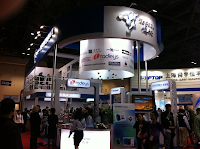Chromatography Quiz #8 Results
We would like to congratulate the grand prize winners of our last newsletter’s Carbamates Analysis Chromatography Quiz: Mary Benzinger from North Coast Laboratories, and Keena Njoroge and Matthew Hartz from Underwriters Laboratories!!!
 They have won, and will shortly be receiving: Wine Hourglasses courtesy of Uncommongoods.com! Additionally, all participants will be receiving a $20 gift card from Jamba Juice! Again, we would like to thank all of you for your submissions.
They have won, and will shortly be receiving: Wine Hourglasses courtesy of Uncommongoods.com! Additionally, all participants will be receiving a $20 gift card from Jamba Juice! Again, we would like to thank all of you for your submissions.
The correct answer for the modified Carbamates chromatogram: the noisy baseline is due to the HPLC pump having excessively large pulsations (or pressure variations). Post-column systems containing reciprocating pumps can also cause noisy pulsations in the baseline, and the frequency of the sine waves should be evaluated to determine which pump is causing the noise.
This problem is most often caused by one of the following: bad pump seals, bad check valves, scratched or damaged pump pistons, faulty pulse dampener, or problems with connections to the pump.
This problem can also be caused by dirty reagents or eluents, however in this case the pulsations would be accompanied by the elevation of the background signal.
We had a lot of excellent responses to this quiz!
Thank you!
Pickering Labs
Chromatography Quiz #9:
Identify the error made when running the Amino Acids chromatogram below and win a prize! Simply email your answer as well as your full contact information to Rebecca at rlsmith@pickeringlabs.comby May 15th in order to win. You will receive email confirmation that your submission has been received. The troubleshooting answer and winner congratulations will be published in the next issue (to be anonymous, please notify Rebecca in submission).
Amino Acid Analysis of Physiological Fluid
Pickering Standard: 1700-0180 Native Sample Standard, acidics and neutrals, in 0.1 N HCl, 2.5 µmole/mL, 10 µL injection
Pickering Column: 0354100T High Efficiency Lithium Cation-exchange Column, 4.0 x 100 mm
Normal Operating Conditions: (for reference only, condition changes may be reflected in chromatogram)
Column Temperature: 36 °C
Flow rate: 0.35 mL/min
Eluent Gradient:
|
TIME
|
Li275 %
|
Li750 %
|
RG003 %
|
|
0
|
100
|
0
|
0
|
|
12
|
100
|
0
|
0
|
|
48
|
65
|
35
|
0
|
|
90
|
0
|
100
|
0
|
|
95
|
0
|
100
|
0
|
|
120
|
0
|
94
|
6
|
|
122
|
0
|
94
|
6
|
|
122.1
|
100
|
0
|
0
|
|
140
|
100
|
0
|
0
|
Post-column conditions for amino acid analysis:
Reagent 1: Trione
Reactor 1: 130 °C, 0.5 mL
Reagent flow rate: 0.3 mL/min
Detection: UV-Vis Detector: 570 nm for primary amino acids, 440 nm for secondary amino acids
 They have won, and will shortly be receiving: Wine Hourglasses courtesy of Uncommongoods.com! Additionally, all participants will be receiving a $20 gift card from Jamba Juice! Again, we would like to thank all of you for your submissions.
They have won, and will shortly be receiving: Wine Hourglasses courtesy of Uncommongoods.com! Additionally, all participants will be receiving a $20 gift card from Jamba Juice! Again, we would like to thank all of you for your submissions. 













